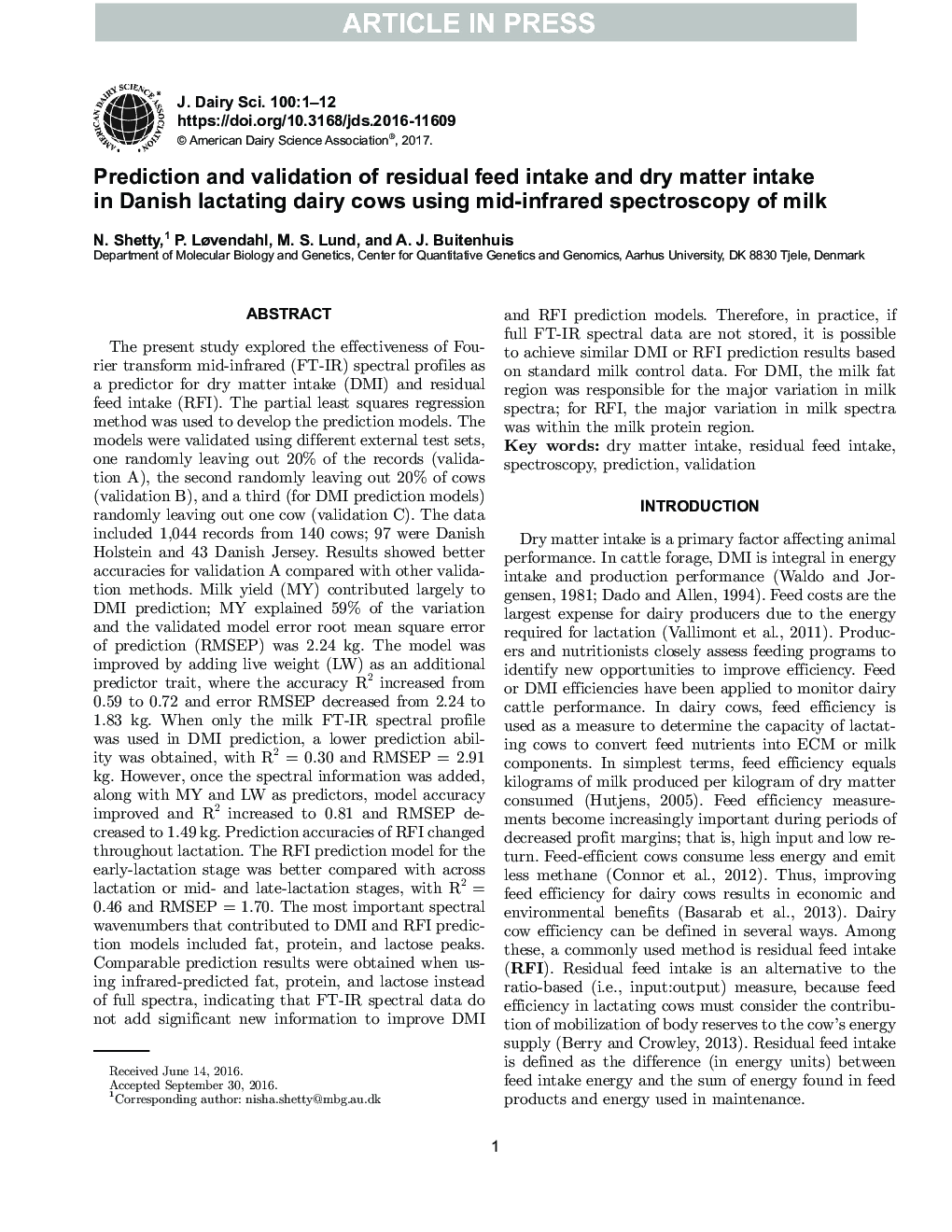| کد مقاله | کد نشریه | سال انتشار | مقاله انگلیسی | نسخه تمام متن |
|---|---|---|---|---|
| 5542568 | 1402520 | 2017 | 12 صفحه PDF | دانلود رایگان |
عنوان انگلیسی مقاله ISI
Prediction and validation of residual feed intake and dry matter intake in Danish lactating dairy cows using mid-infrared spectroscopy of milk
ترجمه فارسی عنوان
پیش بینی و اعتبار مصرف خوراکی باقیمانده و مصرف ماده خشک در گاوهای شیرده شیرخوار دانمارکی با استفاده از طیف سنجی نیمه مادون قرمز شیر
دانلود مقاله + سفارش ترجمه
دانلود مقاله ISI انگلیسی
رایگان برای ایرانیان
کلمات کلیدی
مصرف ماده خشک، مصرف خوراکی باقیمانده، طیف سنجی، پیش بینی، اعتبار سنجی،
موضوعات مرتبط
علوم زیستی و بیوفناوری
علوم کشاورزی و بیولوژیک
علوم دامی و جانورشناسی
چکیده انگلیسی
The present study explored the effectiveness of Fourier transform mid-infrared (FT-IR) spectral profiles as a predictor for dry matter intake (DMI) and residual feed intake (RFI). The partial least squares regression method was used to develop the prediction models. The models were validated using different external test sets, one randomly leaving out 20% of the records (validation A), the second randomly leaving out 20% of cows (validation B), and a third (for DMI prediction models) randomly leaving out one cow (validation C). The data included 1,044 records from 140 cows; 97 were Danish Holstein and 43 Danish Jersey. Results showed better accuracies for validation A compared with other validation methods. Milk yield (MY) contributed largely to DMI prediction; MY explained 59% of the variation and the validated model error root mean square error of prediction (RMSEP) was 2.24Â kg. The model was improved by adding live weight (LW) as an additional predictor trait, where the accuracy R2 increased from 0.59 to 0.72 and error RMSEP decreased from 2.24 to 1.83Â kg. When only the milk FT-IR spectral profile was used in DMI prediction, a lower prediction ability was obtained, with R2Â =Â 0.30 and RMSEPÂ =Â 2.91Â kg. However, once the spectral information was added, along with MY and LW as predictors, model accuracy improved and R2 increased to 0.81 and RMSEP decreased to 1.49Â kg. Prediction accuracies of RFI changed throughout lactation. The RFI prediction model for the early-lactation stage was better compared with across lactation or mid- and late-lactation stages, with R2Â =Â 0.46 and RMSEPÂ =Â 1.70. The most important spectral wavenumbers that contributed to DMI and RFI prediction models included fat, protein, and lactose peaks. Comparable prediction results were obtained when using infrared-predicted fat, protein, and lactose instead of full spectra, indicating that FT-IR spectral data do not add significant new information to improve DMI and RFI prediction models. Therefore, in practice, if full FT-IR spectral data are not stored, it is possible to achieve similar DMI or RFI prediction results based on standard milk control data. For DMI, the milk fat region was responsible for the major variation in milk spectra; for RFI, the major variation in milk spectra was within the milk protein region.
ناشر
Database: Elsevier - ScienceDirect (ساینس دایرکت)
Journal: Journal of Dairy Science - Volume 100, Issue 1, January 2017, Pages 253-264
Journal: Journal of Dairy Science - Volume 100, Issue 1, January 2017, Pages 253-264
نویسندگان
N. Shetty, P. Løvendahl, M.S. Lund, A.J. Buitenhuis,
